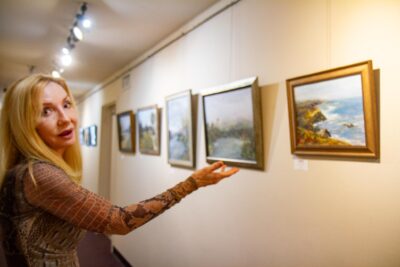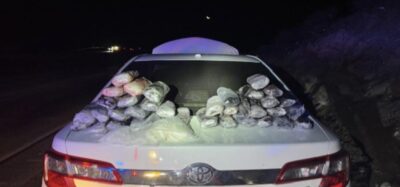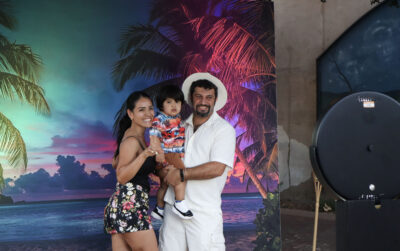By T.J. Muscaro
Contributing Writer
The sun rose high over a packed St. Peter’s Square on Saturday morning as more than a quarter of a million people from all walks of life, from the humble faithful to world leaders, gathered together for the funeral of Pope Francis.
He was a pope among the people, Cardinal Giovanni Battista Re, dean of the College of Cardinals, said in his homily in Italian. He was attentive to the signs of the times and to the anxieties, sufferings, and hopes of this time of globalization.
The funeral began at 10 a.m. local time (4 a.m. EDT), just outside St. Peter’s Basilica. Cardinal Re was accompanied by various cardinals, patriarchs and bishops.
An altar was placed just outside the doors of the iconic basilica, with seating areas for cardinals and dignitaries on both sides. At the base of the parvis, a grid of white squares of seated clergy extended to the onlooker’s left side. Nearly every other space in the square and the Via Della Conciliazione was filled with the faithful.
As pilgrims and politicians alike settled into their places, religious sisters led the entire congregation in recitations of the rosary, while the pontiff’s coffin remained in its place inside, tended to by the Swiss Guard. Dignitaries had a final chance to give an intimate farewell.
In all, about 250 cardinals were expected to attend the Mass, many of whom would soon be called upon to elect the next pope, as well as scores of bishops, priests, religious brothers and sisters, and hundreds of thousands of people from all over the world.
Also expected to attend, according to the Vatican, were delegations from at least 130 nations and international organizations, including 12 reigning monarchs, 14 heads of government, 55 heads of state, and other officials.
Those leaders included U.S. President Donald Trump and First Lady Melania Trump, who celebrated her 55th birthday on Saturday. Argentine President Javier Milei, Italian Prime Minister Giorgia Meloni and Italian President Sergio Mattarella, French President Emmanuel Macron, UK Prime Minister Keir Starmer, and Ukrainian President Volodymyr Zelenskyy were also in attendance.
Cardinal Re emphasized Pope Francis’s mission to reach the world with a gospel of mercy and shape the church to be a home to all, like a field hospital that tends to everyone.
He specifically touched on the late pontiff’s passion for displaced people, refugees, and immigrants, mentioning his visits to the U.S.-Mexico border and to islands in the Mediterranean along dangerous immigration sea routes.
The cardinal also mentioned Pope Francis’s courageous trip to Iraq, where the ISIS terrorist group had previously dominated, and his missions to the Middle East to support interreligious dialogue.
Pope Francis often forcefully reminded us that we are part of the same human family, the cardinal said. The pontiff’s insistence that all the world is one people was on display during the funeral Mass.
The funeral liturgy featured a mix of languages. The first reading from the Acts of the Apostles was read in English, the second reading from St. Paul’s Letter to the Philippians was in Spanish, the Gospel reading from the Gospel of John was in Portuguese, and the prayers of the faithful were given in Arabic, French, Chinese, Portuguese, Polish, and German.
Representatives of the Eastern and Oriental Rite churches also lifted up a prayer and a chant for the late pope.
The cardinal concluded his homily by remembering that Pope Francis often ended his speeches and meetings by telling his audience, “Don’t forget to pray for me.” Re then asked the late pontiff to pray for the people he left behind.
Men and women of various cultural, economic, and religious backgrounds bore witness to the liturgy of the Eucharist. Holy Communion was distributed to the masses of the faithful. The proceedings ended with the Rite of Final Commendation, concluding with the Ultimo Commendation and Valedictio — Latin names for the funeral rite’s final prayer and farewell to formally entrust the deceased to God.
Music was provided by the Choir of the Sistine Chapel.
Pope Francis’ coffin was sprinkled with holy water and incense. At the conclusion of the Mass, 14 pallbearers carried the coffin back into and through St. Peter’s Basilica to where the popemobile was waiting to transport it to its final resting place.
The specially designed white truck is used by the pope for public appearances. Pope Francis’ funeral is the first time it has been used as a hearse.
The coffin was loaded into the open flatbed, and the police-escorted motorcade headed off on its slow journey to the Papal Basilica of St. Mary Major. The journey took the late pontiff over the Tiber River, past the Roman Forum and the Colosseum.
Tens of thousands of faithful lined the route, applauding and cheering as the simple coffin was carried past.
People could be heard cheering “Papa,” the name that Italian, Spanish, and Portuguese believers call the pope. Variations of that cheer, such as “Papa Francesco,” “Grazie, Papa,” and “Viva Papa,” could also be heard.
According to the Vatican, the route followed a path Pope Francis took before and after his 47 apostolic journeys and after his hospital stays to pray before the Salus Populi Romani icon.
By direct request of Pope Francis, a group of poor and needy people referred to as “the last ones” will be at the steps of the basilica to pay their respects before his coffin is interred.
“‘The poor have a special place in God’s heart,’” the Holy See Press Office said in a statement. “So too in the heart and Magisterium of the Holy Father, who chose the name Francis so as to never forget them.”
Inside the basilica, a tomb between the Pauline Chapel and the Sforza Chapel, close to the Altar of St. Francis, has been prepared to receive him. One chapel is dedicated to the Blessed Mother, and the other serves as a place of Eucharistic adoration.
His tomb will also be bookended on either side by places to receive the Sacrament of Reconciliation.
The procession into the basilica included members of the Swiss Guard, Dominican priests, and members of the College of Cardinals.
Four children laid flowers before the Salus Populi Romani icon, in front of which Francis had prayed more than 100 times. Pallbearers turned his coffin toward the icon of St. Mary, mother of Jesus, before moving it to his tomb.
The burial rite was set to be done privately, presided over by Cardinal Kevin Farrell, the Vatican’s Cardinal Camerlengo, or chamberlain. Farrell will be joined by several other officials who are required to take part in the liturgical celebration. Those include Cardinal Re; Cardinal Stanislaw Rylko, the archpriest of the Papal Basilica of St. Mary Major; Cardinal Pietro Parolin, Vatican secretary of state under Pope Francis; and Cardinal Baldassare Reina, vicar general for the Diocese of Rome.
Francis’s coffin was set to be placed in the tomb and sprinkled with holy water as participants recited the Regina Cæli prayer.
Afterward, an official act confirming the burial was to be drawn up and read aloud by the notary of the Liberian Chapter, signed by Cardinal Camerlengo, the Master of Papal Liturgical Celebrations, the Regent of the Papal Household, and the notary.
This is the third papal funeral held by the Vatican in this millennium. The entire ceremony ended shortly after 2 p.m. local time.
Pope Benedict XVI’s funeral in 2023 lasted about two hours, while the 2005 funeral for Pope St. John Paul II lasted about three hours. The funeral Mass for Pope Francis was a little more than two hours long because the late pontiff had chosen not to be buried within St. Peter’s Basilica, breaking with tradition and adding to the event’s length.









